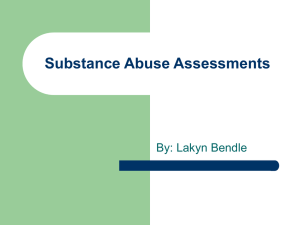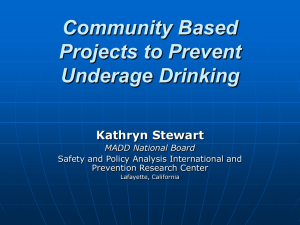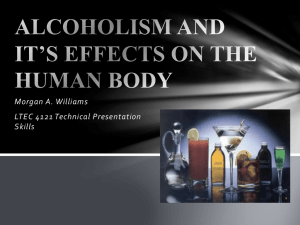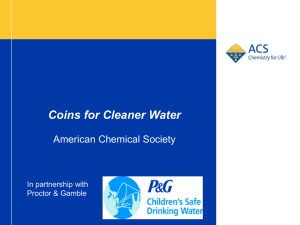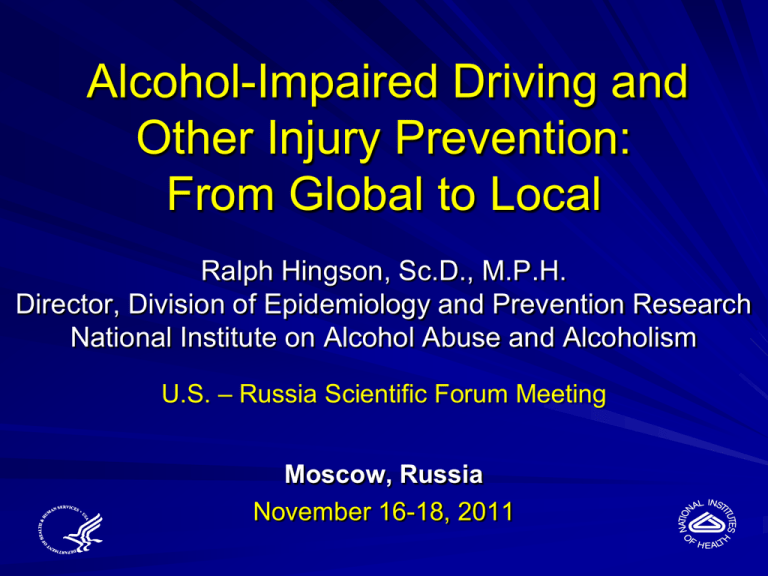
Alcohol-Impaired Driving and
Other Injury Prevention:
From Global to Local
Ralph Hingson, Sc.D., M.P.H.
Director, Division of Epidemiology and Prevention Research
National Institute on Alcohol Abuse and Alcoholism
U.S. – Russia Scientific Forum Meeting
Moscow, Russia
November 16-18, 2011
Alcohol and Global Health
Growing concern worldwide
World Health Assembly charged WHO with
developing a Global Strategy Strategic Plan to
reduce harm linked to alcohol (report due in Spring
2010)
WHO Conferences in six regions:
• Stakeholders (producers and sellers of alcohol)
• NGOs
• Government representatives of member countries
(report draft under review)
U.S. delegate for Regional Meeting of the Americas
in Sao Paulo, Brazil, May 4-6, 2009
Data monitoring meeting, Valencia, Spain, Oct. 2124, 2009
Alcohol and Global Health, 2004
2,255,000 net alcohol-attributable deaths (3.8%
of all deaths)
666,000 unintentional injuries
272,000 intentional injuries
545,000 cardiovascular disease
487,000 cancer
373,000 cirrhosis of the liver
135,000 neuropsychiatric diseases
237,000 deaths prevented (protective effects,
heart disease)
Source: Rehm et al., The Lancet, 2009
Global Per Capita Alcohol Consumption
Source: Rehm et al., The Lancet, 2009
Global Burden of Alcohol Misuse
The 8th leading cause of death
The leading cause of death for males ages 15-59
Alcohol as Leading
Cause of Death
Percent of Disability
Adjusted Life Years
(DALYs) Attributable to
Alcohol
Europe
6.5%
11.6%
Americas
5.6
9.2
Western Pacific Region 5.3
7.2
Africa
2.4
2.1
South East Asia
2.3
2.7
Eastern Mediterranean
0.5
0.5
World in 2004
3.8
4.6
World in 2000
3.0
4.0
Source: Rehm et al., The Lancet, 2009
Global Road Safety
1.2 million traffic deaths annually
9th leading cause of death
– #1 cause ages 15-29
– #2 cause ages 5-14
– #3 cause ages 30-44
20-50 million injuries annually
Source: World Health Organization, Global Status Report on Road Safety, 2009
Globally there is a special concern
about youth and alcohol
• 1/3 of traffic deaths worldwide are under
age 25 (over 400,000 annually)
At BAC 0.05%
• Young adult drivers have 2.5 times the
crash risk as older more experienced
drivers
(Source: WHO Top 10 Youth Traffic Facts)
Alcohol in Fatal Crashes
Reports from 93 countries
In 29% of countries, 30% or more of fatal
crashes involve alcohol
WHO recommends 0.05% legal BAC
– Only half of countries with legal BAC limits
have a BAC of 0.05% or lower
– Only 19 of 139 countries with BAC limits have
lower limits for young novice drivers
Source: World Health Organization, Global Status Report on Road Safety, 2009
Trends in Road Traffic Safety
Rates in Selected High-Income
Countries
Source: World Health Organization, Global Status Report on Road Safety, 2009
Alcohol-Related traffic deaths have declined
since the early 1980s in many high-income
countries, including:
•
•
•
•
•
•
•
•
Australia
Canada
France
Germany
The Netherlands
Sweden
United Kingdom
United States
Source: Sweedler and Stewart, “Worldwide Trends in Alcohol and Drug Impaired Driving,” in
Drugs, Driving and Traffic Safety, Verster et al. (Eds.), Birkhauser Verlag AG, 2009
Low/Middle Income Countries
Traffic deaths and injuries are increasing
90% of traffic deaths worldwide
• Twice the death rate/100,000 as high income
countries
• Less than ½ registered vehicles
Nearly half of traffic deaths are:
• Pedestrians
• Motor cyclists, bicyclists, or passengers in
public transport
Source: World Health Organization, Global Status Report on Road Safety, 2009
Concern
Alcohol-Related Fatal Crashes will
increase in developing countries:
• Increase in motor vehicle crashes
• Increases in per capita alcohol consumption
“Economic Development is usually
associated with an increase in levels of
both alcohol consumption and alcohol
problems”
-- Room et al. European Addiction Research
(2003)
Related Risks
Only 29% of countries meet basic criteria for
reducing speed in urban areas
Only 57% of countries have seat belt laws
Only 20% of low income countries have child
restraint laws vs. 90% of high income countries
Only 40% of countries have a motor cycle
helmet law
Only 20% of countries have an information
system to monitor road traffic injuries and costs
Source: World Health Organization, Global Status Report on Road Safety, 2009
Alcohol Attributable Deaths in the
United States, Annual Average,
2001-2005
79,696
3rd leading cause of preventable deaths
Injury (including poisoning): 43,731
Chronic disease: 35,915
Source: CDC, ARDI, 2009
Alcohol Attributable Deaths:
Conditions 43,731
Motor Vehicle Traffic
Acute
13,819
Homicide
7,787
Suicide
7,235
Falls
5,532
Poisoning (Not alcohol)
5,416
370
Poisoning (Alcohol)
Fire Injuries
Drowning
Other
Source: CDC: ARDI, 2009
1,158
868
1,546
Alcohol- vs. Non-Alcohol-Related Traffic Fatalities,
Rate Per 100,000, All Ages, United States, 1982-2008
12.00
11.3
(n=26,173)
Non-Alcohol-Related ↓ 7%
10.00
8.00
7.67
6.00 (n= 17,772)
4.00
7.14
(n= 21,823)
Alcohol-Related ↓ 55%
5.05
(n= 15,438)
2.00
0.00
1982 1984 1986 1988 1990 1992 1994 1996 1998 2000 2002 2004 2006 2008
Sources: National Highway Traffic Safety Administration, 2009; U.S. Census Bureau, 2009
From 1982-2001 in the U.S, 153,168 lives were
saved by decreased drinking and driving. This
is more than the combined numbers of lives
saved by increased use of
–
–
–
–
Seat belts
129,297
Airbags
4,305
Motorcycle helmets
6,475
Bicycle helmets
239
Total 140, 316
Source: Cummings, Rivara, Olson, Smith. Injury Prevention, 2006.
Haddon Matrix
Human
(Host)
Vehicle and
Equipment
(Agent)
(Environment)
Pre Crash
•Price
•Minimum
Purchase Age
•DWI
Laws/Enforcement
•Lights/Braking
•Ignition
Interlock
•Speed
•Rumble Strips
•Signals/Signs
Crash
•Belt Use Primary
Law
•Helmet Laws
•Airbags
•Collapsible
Steering
Column
•Guard Rails
•Divided
Highway Design
Post Crash
•Cell Phone
•First Aid/CPR
•Trauma Center
Alcohol Screening
•Non-Exploding •EMS Trauma
fuel tank
Center
•Crash Analyses
When to Use Laws to Change
Behavior to Promote Health
Problem is important
Law is effective
Law is minimally intrusive
No less intrusive equally effective
alternative
Behavior harms others
Public Supports The Law
Environmental Policy Interventions
Legislation to reduce drinking & driving
– Criminal per se laws
– Administrative license revocation laws
– Mandatory assessment & treatment laws
– Primary safety belt laws
– Ignition interlock for first offenders
– Lower legal blood alcohol limits for convicted
offenders
– 0.08% criminal per se BAC level laws
– Zero tolerance laws
Enhanced enforcement- publicized sobriety
checkpoints
Environmental Policy Interventions
Legislation to reduce availability of alcohol
– Minimum legal drinking age
(Shults et al., Am. J. Prev. Med., 2001; Wagenaar &
Toomey, J. Stud Alcohol Drugs, 2002; Institute of
Medicine, 2004)
– Reduce alcohol outlet density
(Gruenwald & Remer, Alcohol: Clin. Exp. Res., 2006;
Campbell et al., Am J Prev Med, 2009)
– Increase price
(Wagenaar et al., Addiction, 2009; Institute of Medicine,
2004; Elder et al., Am J Prev Med, 2010; WHO, 2009;
Maldonado-Molina & Wagenaar, ACER, 2010)
30
20
Austria
Belgium
Bulgaria
Croatia
Cyprus
Czech Republic
Denmark
Estonia
Faroe Islands
Finland
France
Germany
Greece
Hungary
Ireland
Isle of Man
Italy
Latvia
Lithuania
Malta
Monaco
Netherlands
Norway
Poland
Portugal
Romania
Russia
Slovak Republic
Slovenia
Spain
Sweden
Switzerland
Ukraine
U.K.
United States
National Institute on Alcohol Abuse and Alcoholism
Percent Drunk in Past Year, Students Ages 15-16,
ESPAD 2007
80
73
70
62
60 57
58
51
50
46 45
47
40
29
4242
45
48
25
50
43
45
36
28
46
42
37 36
35
40
40
32
42
37
40
32
35
25 26
18
10
0
Compared to Other Regions of the World
National Institute on Alcohol Abuse and Alcoholism
Europe has the highest:
• Per capita alcohol consumption:
11.9 liters pure alcohol vs. 6.2 liters worldwide
• Percent of deaths that are attributable to alcohol :
6.5% vs. 3.2% worldwide
• Alcohol-Attributable burden of disease (measured
in disability-adjusted life years (DALYs)):
11.6% vs. 4% worldwide
• Past year prevalence of alcohol use disorders:
– 5.5% Western Europe
– 10.9% Eastern Europe
– 3.6% worldwide
Source: Rehm J et al., Alcohol and Global Health, Lancet 373, 2223-2233, 2009.
29
50
Federal 21
Drinking Age
Drinking Age 21 in all states
45
Full-time College Students
40
35
Other 1-4 Yrs. Past HS
30
Percent
National Institute on Alcohol Abuse and Alcoholism
Alcohol: Trends in 2-Week Prevalence of 5 or More
Drinks in a Row among College Students vs.
Others 1-4 Years Beyond HS
25
12th Graders
20
15
10
5
0
1978 1980 1982 1984 1986 1988 1990 1992 1994 1996 1998 2000 2002 2004 2006 2008
Source: Monitoring the Future, 2007
National Institute on Alcohol Abuse and Alcoholism
Alcohol- vs. Non-Alcohol-Related Traffic Fatalities,
Rate Per 100,000, Ages 16-20, United States,1982-2008
U.S. MLDA Age 21 law
MLDA 21 in all 50 states
30
25.58
(n=5,244)
Non-Alcohol-Related ↓ 1%
25
13.19
(n=2,853)
20
15
10
13.36
(n=2,738)
Alcohol-Related ↓ 70%
5
7.60
(n=1,644)
0
1982
1984
1986
1988
1990
1992
1994
1996
1998
2000
2002
2004
Sources: U.S. Fatality Analysis Reporting System, 2009; U.S. Census Bureau, 2009
2006
31
2008
National Institute on Alcohol Abuse and Alcoholism
Legal Drinking Age Changes
CDC reviewed 49 studies published in
scientific journals
Alcohol-Related Traffic Crashes:
- Increased10% when the drinking age was
lowered
- Decreased 16% when the drinking age was
raised
Source: Shults et al., American Journal of Preventive Medicine, 2001
National Institute on Alcohol Abuse and Alcoholism
James Fell et al.
The Impact of Underage Drinking Laws on Alcohol-Related
Fatal Crashes of Young Drivers
Alcohol Clin Exp Res, 2009
Methods
• Analysis of the Fatality Analysis Reporting System from 1982-2004
• Examined the effects of the minimum legal drinking age of 21 on
the ratio of drinking to non-drinking drivers under age 21 in fatal
crashes
• Controlled for:
–
–
–
–
–
–
–
–
–
–
–
–
–
–
Zero Tolerance Laws
Graduated License Night Restrictions
Use/Lose laws
Administrative License Revocation
.10, .08 BAC per se
Mandatory seat belt laws
Per capita beer consumption
Unemployment rate
Vehicle miles traveled
Frequency of sobriety checkpoints
Number of licensed drivers
Ratio of drinking to non-drinking drivers
Age 26+ in fatal crashes
Ratio of drinking to non-drinking drivers age 26+ in fatal crashes
Fell et al., Alcohol Clin Exp Res, 2009 (cont)
National Institute on Alcohol Abuse and Alcoholism
Results
• Minimum legal drinking age was independently associated with a 16%
decline in the ratio of drinking to non-drinking drivers in fatal crashes under
age 21
• Other laws that independently predicted lower involvement of drinking drivers
under age 21 in fatal crashes:
–
–
–
–
–
Use/Lose laws
↓5%
Zero tolerance laws
↓5%
0.08% BAC limit
↓ 8%
0.10% BAC limit
↓ 7%
Administrative license ↓ 5%
revocation (ALR)
– Seat belt laws
↓ 3%
Conclusions
• Minimum legal drinking age of 21 reduced involvement of drinking drivers
under 21 in fatal crashes (16%)
• Zero tolerance laws and Use/Lose laws targeted drivers under 21 also
produced reductions
• Laws targeting drinking drivers of all ages also reduced involvement of
drinking drivers under 21 in fatal crashes (0.08% and .10% BAC limits, ALR,
seat belt laws)
National Institute on Alcohol Abuse and Alcoholism
Cumulative Estimated Number of Lives
Saved by the Minimum Drinking Age Laws
1975-2007
30,000
25,509
24,619
25,000
23,737
20,970
20,043
20,000
15,000
26,333
22,810
21,892
19,121
18,220
17,359
16,513
14,816 15,667
13,968
13,152
12,357
10,000
5,000
0
19751991
1993
1995
1997
1999
2001
2003
Source: National Highway Traffic Safety Administration
2005
2007
10 Reasons for Legal Drinking
Age of 21
Alcohol-related traffic
fatalities and injuries
Other unintentional
injuries (falls,
drownings, burns)
Homicide and assault
Sexual assault
Suicide
STDs, HIV/AIDS
Unplanned pregnancy
Alcohol dependence
Teen drug use
Poor academic
performance
*Nearly 5,000 alcohol related injury deaths among
youth under 21
Norberg et al. Long-Term Effects of Minimum
Drinking Age Laws on Past-Year Alcohol and
Drug Use Disorders, Alcohol Clin Exp Res, 2009
Examined:
• 1991 National Longitudinal Alcohol Epidemiological Survey
(NLAES)
• 2002 National Epidemiologic Study on Alcohol and Related
Conditions (NESARC)
Studied:
• 33,869 subjects
– 18,539 NLAES
– 15,330 NESARC
• Cohorts:
– Reached 18
1948-55: Were 18 when alcohol purchase ages were lowered.
1956-70:
were raised.
Norberg, 2009 (cont.)
Compared persons in states with drinking ages below 21
and 21
Controlled for:
• Gender
• Parental alcohol problems
• Survey
• State beer tax
• Race/Ethnicity
• When 18 years old
• Sate of Residence • Education
• State of birth
• Employment
• Marital status
• Children in home
Results:
• Adults allowed to purchase before age 21 had higher odds of
past-year:
– Alcohol use disorder 1.31(1.15, 1.46)
– Drug use disorder 1.70 (1.19, 2.44)
(even in 30s and 40s)
Grant et al. 1998
National Institute on Alcohol Abuse and Alcoholism
Early Drinking Onset and Alcohol
Dependence: Twin Study Results
Early age of starting to drink is significantly
associated with the development of
alcohol dependence comparing twins
when one began to drink earlier than the
other
(even among monozygotic “identical”
twins, thus fully controlling for genetics)
J. Grant et al. Psychological Medicine, 2006
National Institute on Alcohol Abuse and Alcoholism
Earlier Age Drinking Onset Also
Related to:
More rapid development of dependence
Dependence by age 25
Of ever dependent
47% before age 21
2/3 before age 25
Chronic Relapsing Dependence
•
•
•
•
•
Longer episodes
Multiple episodes
Past year dependence
More symptoms
Early dependents less likely
to seek help
Hingson, Heeren and Winter 2006 Archives Pediatric and Adol Med
Hingson, Heeren and Winter 2006 Pediatrics
Brian Paul McKelvey
National Institute on Alcohol Abuse and Alcoholism
Earlier drinking onset is also
related to
Motor vehicle crashes (Hingson et
al., 2002)
Unintentional injuries (Hingson et
al., 2006)
Physical fights after drinking
(Hingson et al., 2001)
Injuring self and others under the
influence (Hingson & Zha, 2009)
Motor vehicle crash involvement
because of drug use (Hingson et al.,
2008)
Michael Timothy Wilder42
National Institute on Alcohol Abuse and Alcoholism
Early Age of Drinking Onset also
Associated with:
Suicide
– Swahn et al., Pediatrics, 2008; Bossarte & Swahn, Addict Behav,
2011
Violent behavior, including predatory violence
– Blitstein et al., Health Educ Behav, 2005; Ellickson, et al.,
Pediatrics, 2003
Dating violence/victimization
– Ramisetty-Mikler et al., J Sch Health, 2006
Criminal behavior
– Eaton, J. Interpers Violence, 2007; Allan et al., S. Afr Med J,
2007.
Prescription drug ,misuse
– Hermos et al., J. Addict Med., 2008
Unplanned and unprotected sex after drinking
– Hingson et al., Pediatrics, 2003
50
45
40
Percent
National Institute on Alcohol Abuse and Alcoholism
Where do Young Teens Obtain Alcohol? U.S.
Drinkers, Ages 12-20, Source of Alcohol Used
in Past Month, by Age, 2006
35
45%
15%
30
25
13%
20
5%
15
10
22%
14%
2%
8%
9%
17%
5
8%
4%
0
Ages 12-14
Ages 15-17
Ages 18-20
Took From Home
Other Family
Parents
Source: SAMHSA, Underage Alcohol Use: Findings from the 2002-2006 National Surveys on Drug Use and Health, 2008
National Institute on Alcohol Abuse and Alcoholism
Studies Indicating a Statistically Significant
Association Between Parents Providing Alcohol
at Home to Their Children and Subsequent Heavy
Alcohol Use or Problems Among Those Children
Home Availability Linked to Heavier Childhood Drinking:
• McMorris et al., J Stud Alcohol Drugs 72: 418-428, 2011
• Van Den Eijnden et al., J Stud Alcohol Drugs 72: 408-417,
2011
• Van der Vorst, J Stud Alcohol Drugs 71: 105-114, 2010
• Livingston et al., Addict Behav 35(12): 1105-1112, 2010
• Komro et al., Addiction 102: 1597–1608, 2008
• Lundborg, Vulnerable Child Youth Stud 2(1): 60-70, 2007
• Foley et al., J Adol Health 34(5): e17-e26, 2004
• Jackson et al., J Stud Alcohol 60: 362-367, 1999
• Dielman et al., J Sch Health 59(6): 255-263, 1989
National Institute on Alcohol Abuse and Alcoholism
Why Are These Findings
Important?
Injuries are the leading cause of
death among youth 1-44
Unintentional injuries #1 1-44
Intentional injuries #2 8-34
Source: Centers for Disease Control and Prevention
Why Are These Findings
Important?
Alcohol is involved over 50,000 injury deaths
annually* (Nearly 44,000 attributable to alcohol)
40% unintended injury
deaths
47% Homicides
29% Suicides
39,000
8,000
8,500
Alcohol is the leading contributor to injuries & the leading
cause of death among young people in the United States
Source G. Smith et. al 1999;
CDC, 2009
* Over half under age 44
BAC and Impairment
.1 0
.0 9
.0 8
.0 7
.0 6
.0 5
.0 4
.0 3
.0 2
.0 1
BAC
Concentrated Attention, Speed Control,
Braking, Steering, Gear Changing,
Lane Tracking, Judgement
Tracking, Divided Attention, Coordination,
Comprehension, Eye Movement
Simple Reaction Time, Emergency Response
Choice Reaction Time
Key driving functions are impaired at levels as
low as .02-.04%.
Source: National Highway Traffic Safety Administration
Relative Risk of Fatal Crash
Relative Risk of Fatal Crash
Drivers Age 16-19 and 20+ As a
function of BAC
10.0
16-19 y.o.
9.0
8.0
Increased Risk of Driver Single
Vehicle Crash Death at Blood
Alcohol Concentration of .08% .10% Relative to Sober Drivers
Male
7.0
6.0
5.0
4.0
20+ y.o.
3.0
2.0
Age 16-20
21-34
35+
Relative
Risk
51.4
13.4
11.4
1.0
0.0
0
.015-.049
.050-.079
Blood Alcohol Concentration (mg%)
The risk of fatal crash increases
more with each drink among young
drivers than drivers age 20 and older.
Source: Simpson, H. 1989
Source: Zador P., Krawchuck S., Voas R., J. Studies on
Alcohol, 2000
Proportion of Teen Fatal Crashes Involving Single
Vehicles at Night
Percent
40%
Before and After Zero Tolerance Laws for Youth
Comparison
Zero Tolerance
Before
After
Before
31.3
31.7
31.6
30%
After
Comparison
1%
25.1
Zero
Tolerance
21%
20%
10%
0%
SVNF
Fatal Crashes
1439
4597
1079
3400
Source: Hingson, Heeren, Winter, 1994
1150
3637
717
2851
Hingson, Heeren, Winter – AJPH (1996)
.08 Laws
.08 Law
States
Comparison
States
Date .08%
Law Effective
Analysis
Period
Utah
Idaho
August 1983
Aug. 1976 – July 1991
Oregon
Washington
November 1983
Nov. 1976 – Oct. 1991
Maine
Massachusetts August 1988
Aug. 1984 – July 1993
California
Texas
Jan. 1986 – Dec. 1993
Vermont
New Hampshire July 1981
January 1990
July 1990 – June 1993
Hingson, Heeren, and Winter 1996
American Journal of Public Health
Conclusion:
“.08 laws, particularly in combination with
administrative license revocation, reduce the
proportion of fatal crashes involving drivers and
fatally injured drivers with blood alcohol levels at
.08% or higher and .15% or higher.”
After subtracting 6-9% alcohol related fatal crash
declines associated with ALR in prior national
studies, we projected that if all state adopted
.08% laws, 500-600 fewer fatal crashes would
occur each year.
Key ABI Arguments
.08% law a feel good law that will not reduce
alcohol-related traffic deaths
.08% laws target social drinkers, not high
BAC offenders; over ½ drivers in alcoholrelated fatal crashes have BACs above .15%
MADD prohibitionist .08% first step down
slippery slope (“Impairment begins with 1st
drink” proves it)
- MADD more concerned with raising money than
reducing traffic deaths
- Hingson 1996 study of .08% laws flawed
• Compared California with Texas, not a nearby state
• Other comparisons preferable, e.g. Mythical State,
Michigan, Ohio, Pennsylvania (Scopatz, 1998)
• Not possible to separate effects of .08 laws from ALR
• Clinton relied too heavily on Hingson study
- .08% laws will clog courts with new cases and fill jails
- This will cost $$
- Every year the majority of states considering .08 laws
defeat them
- A 120 pound woman would reach .08% after 2 drinks;
she would lose her license, be called a criminal and
face jail time
Ten studies have been conducted in the U.S.
that examined multiple states that adopted
.08% Per Se Laws
- Johnson & Fell (1995)
- Hingson, Heeren, Winter (1996)
- Apsler et. al. (1999)
- Voas, Tippetts, Fell (1999, 2000)
- Hingson, Heeren, Winter (2000)
- Dee (2001)
- Shults et al. (2001)
- Eisenberg (2003)
- Bernat et al. (2004)
- Tippetts et al. (2005)
- Every study found significant reductions in fatal crash
measures involving drinking drivers
Is Passing Laws Enough?
Potential Process of Change
After a Drinking Age Increase
Police and Enforcement
Legal Drinking
Age Increase
Court Enforcement
Public Education
Who
- Minors
- Alcohol Outlets
What
- Reasons for Law
- Enforcement
General Legal
Deterrence
Reduction
In
Drinking
&
Driving
After
Drinking
Changes in Public
Perception about
Alcohol
Fatal and
Night
Fatal
Crash
Reductions
Comprehensive Community
Interventions
Involve multiple departments of city government
and private citizens
Use multiple program strategies
•
•
•
•
•
•
Education
Media advocacy
Community organizing and mobilization
Environment policy change
Heightened enforcement
Expand alcohol treatment
Successful Comprehensive
Community Interventions
Saving Lives Program, Hingson (1996)
Project Northland, Perry (1996)
Communities Mobilizing for Change, Wagenaar (2002)
Community Trials, Holder (2000)
A Matter of Degree, Weitzman (2004)
Fighting Back, Hingson (2005)
Sacramento Neighborhood Prevention, Treno, (2007)
State Coalitions to Reduce Underage Drinking, Wagenaar
(2007)
Neighborhoods Engaging with Students (NEST), Saltz
(2009)
College community program, McCartt et al. (2009)
Communities That Care, Hawkins et al. (2009)
Safer California Universities, Saltz et al. (2010)
Comprehensive community
interventions address college age and
underage drinking at multiple levels
-
Coordinate multiple city departments
Clear measurable Objectives and Strategic Plans
Combine Education and Law Enforcement
Include screening and early interventions
Use Data to Plan and Evaluate
Involve Private Citizens – Be Inclusive
Involve Youth
National Institute on Alcohol Abuse and Alcoholism
Conclusions
Research indicates reductions in underage
and college age drinking and related
problems can be achieved with interventions
that focus on
- Individuals
- Families
- Schools
- Environmental Changes/Legislation
Interventions targeting multiple levels are
more effective
National Institute on Alcohol Abuse and Alcoholism




